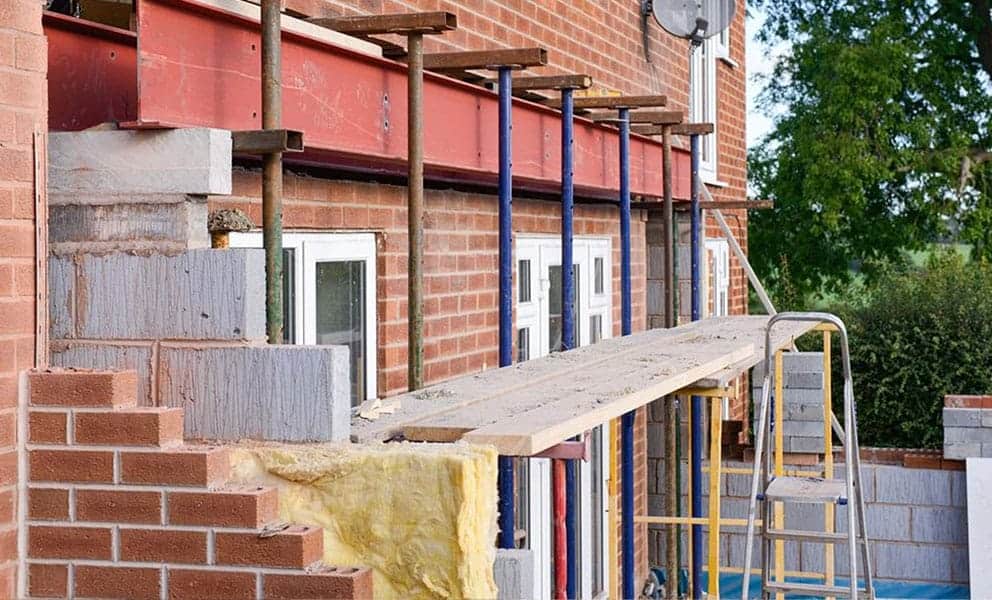
In this post, we’ll discuss five cavity wall insulation problems and how to avoid them.
One of the most fundamental cavity wall insulation problems is that it's not suitable for all homes. As the name suggests, cavity wall insulation requires a wall cavity where insulation can be added. Some homes built in the early 20th century or earlier will have solid walls rather than cavity walls.
If you’re unsure of your wall type, measuring can usually give you a good idea. Walls that are over 260mm thick will usually have a cavity, while narrower walls are most likely solid. Or you can check your EPC. Search online using your postcode if you don’t have it to hand.
Another option is to check the brick pattern on your property. Walls with a cavity typically have bricks laid lengthways in an even, continuous pattern. In contrast, solid walls often have an uneven pattern with some bricks laid sideways. You can tell because you’ll see the small end of the brick on your wall’s exterior.
Other buildings that are unsuitable for cavity wall insulation are those in areas with wind-driven rain. A map from the NHBC shows that the main areas of exposure are along the west coasts of Scotland, England and Wales.
Wind-driven rain soaks external brickwork, which can lead to water ingress and cavity wall insulation becoming damp. Once damp, it loses its insulating properties, rendering it ineffective for heat retention.
If water does get through your external brickwork, it might not be a problem when there’s a cavity in your wall. However, by filling that void, cavity wall insulation essentially acts as a moisture bridge. It allows moisture to pass through the entire wall and into your building. That can lead to damp and mould inside your home, plus the eyesores and health risks that come with it.
First and foremost, nobody wants a damp patch on their walls because it looks unpleasant with a smell to match. Additionally, when internal walls become damp, it’s only a matter of time before mould develops due to the moist environment.
Mould releases spores which are dangerous to those exposed, as they can trigger allergic reactions, cause health issues and worsen existing conditions. Amongst the most vulnerable are babies, children and the elderly – as well as people who are already living with illness. It can also be irritant for the skin and eyes when touched.
Another problem comes with breathability. Above all else, cavity wall insulation aims to stop heat getting through your external walls. In doing so, however, it can also prevent moisture from escaping. Without alternative ventilation, that moisture becomes trapped in your home, causing humidity levels to rise and – as above – issues with damp and mould to develop.
Rather than penetrating damp (from outside), this is damp from condensation (inside). In short, all homes naturally produce moisture from things like cooking, washing and breathing. That can escape through permeable walls or other ventilation sources, including windows, extractor fans and air bricks.
Insulation needs to be breathable in certain homes where alternative ventilation isn’t present. Otherwise, you’ll suffer from high levels of condensation on walls, ceilings and windows. That will eventually become damp and distressing. This is discussed at length in our article on breathable insulation benefits.
If cavity wall insulation isn’t installed correctly, there’s also the problem of inefficiency. Any underfilling, slumps or gaps can lead to cold bridges in your walls. These areas allow the cold through, creating concentrated cold areas within your home. They are basically a magnet for moisture and damp, not to mention making the insulation itself much less effective.
Unfortunately, given the nature of cavity wall insulation, this problem isn’t immediately visible – or in fact visible at any point. You have to put your trust in the contractor installing your installation. If they don’t do it properly, it could be years before you discover cold bridges in your walls. Whatever the case, it means your investment has been wasted and you’ll need to fork out to fix it.
From unsuitability to cold and moisture bridges, there are a range of cavity wall insulation problems that make it ineffective, and even damaging, to your home. CorkSol provides an alternative, with internal and exterior wall coatings that add insulation without these issues.
Our natural SprayCork solution can be applied to both solid and cavity walls with the same great benefits. Rather than insulating the cavity, our approved applicators add insulation to the surface of walls on the inside our outside of your home.
Internally, the coating is just 8mm thick, so you don’t have to worry about impacting the size of your living space. That includes a 2mm plaster overskim, so you can decorate your insulated walls with ease.
On the outside, SprayCork is applied as a render, which means there’s no need to adjust fixtures like windows, doors and gutters. There’s even a choice of 28 colours to match your existing render or transform your walls.
Most importantly, it’s highly insulative, breathable and completely moisture-resistant, so you can keep your home well insulated while also avoiding issues with damp and mould.
If you want to sidestep cavity wall insulation problems, CorkSol can help. We have a network of approved applicators throughout the UK, who have been fully trained to apply SprayCork to the highest standards. Get in touch today to arrange a quote from a trusted contractor near you.
"*" indicates required fields